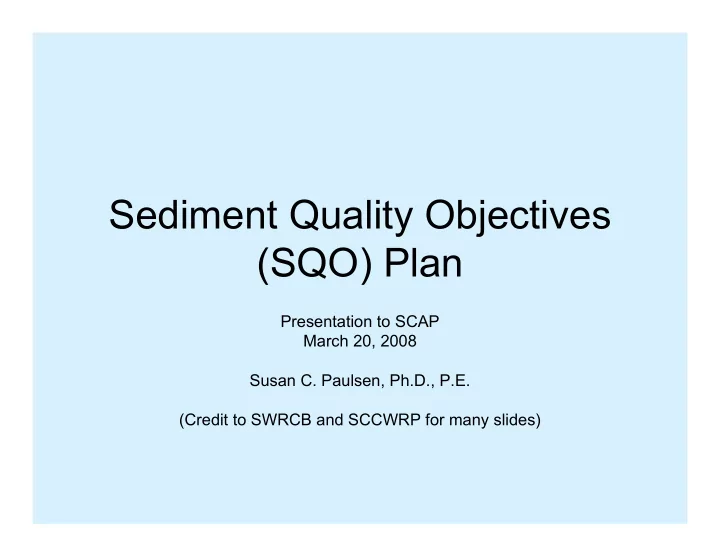

Sediment Quality Objectives (SQO) Plan Presentation to SCAP March 20, 2008 Susan C. Paulsen, Ph.D., P.E. (Credit to SWRCB and SCCWRP for many slides)
Overview • Background • Overall SQO approach • Draft Plan and Phase 1 SQO approach • Questions?
What are Sediment Quality Objectives? • SQOs provide “a means to differentiate sediment impacted by bioavailable toxic pollutants from those that are not” • Similar to water quality objectives
Why do SQO now? • 1989 amendments to California Water Code required SQO development • 1999-2001: lawsuit filed, consent decree entered, with following schedule: – June 2003: work plan – August 2006: first draft SQO – February 29, 2008: SWRCB must adopt SQO and implementation policy, forward to OAL (with extension)
Who’s involved? • SWRCB leads effort (Chris Beegan) • Science team (SCCWRP and SFEI) develops • Scientific Steering Committee (SSC) • Advisory Committee
SQOs will be phased • Phase 1 (February 2008) – Narrative objectives for direct and indirect effects – Methods for evaluating direct effects SQO for enclosed bays and harbors • Phase 2 (February 2009) – Methods for evaluating direct effects SQO for estuaries, including Delta – Methods for evaluating indirect effects SQO for human health • Phase 3 (TBD) – Methods for evaluating indirect effects SQO for wildlife
Overall Sediment Assessment Human Benthic Wildlife Health organisms Sediment Sediment Sediment Chemistry Chemistry Chemistry Methods in development Prey Prey Benthic Bioaccumulation Bioaccumulation Toxicity Tissue Tissue Community Test Test Chemistry Chemistry Direct Effects SQO Indirect Effects SQO Phase 1 Phase 2
MLOE Approach (direct effects) 1. Sediment chemistry 2. Sediment toxicity laboratory bioassays 3. Benthic community composition
Why MLOE? Toxicity ≠ f(chemical concentration) Copper ERL ERM 120 100 S u r v iv a l( % ) 80 60 40 20 0 1 10 100 1000 10000 Coppe r ( MG/ KG) AET PAET Nont oxic Toxic
Why MLOE? Copper Severely Severely Affected Affected Affected Affected Marginal Marginal Reference Reference Concentration (log mg/kg) Benthic community composition ≠ f(chemical concentration)
MLOE process Collect and analyze samples Collect and analyze samples Chemistry, Toxicity, Benthos Chemistry, Toxicity, Benthos Compile and summarize data Compile and summarize data QA review, means/sums QA review, means/sums Apply Indicators for each LOE Apply Indicators for each LOE Indices and thresholds Indices and thresholds Determine LOE Category Determine LOE Category Integrate indicators Integrate indicators Station impact assessment Station impact assessment Compare LOEs Compare LOEs
Station assessment • Unimpacted • Likely Unimpacted • Possibly Impacted • Likely Impacted • Clearly Impacted • Inconclusive
Application of MLOE
San Francisco Bay
LA/LB Harbor Area
Statewide Assessment Results
Steps following SQO exceedance • Apply 303(d) listing test • Conduct stressor identification – Are toxic pollutants causing impact? – Which toxic pollutants? • Following pollutant ID – Modify listing – Identify sources – Develop management guidelines
Site-specific management guidelines • Determine site-specific level of stressor pollutant that will meet SQO • Do not use sediment quality guidelines (ERMs, TELs, etc.) • Regional Boards to determine implementation actions
Who is responsible? • Current NPDES permittees with discharges to regulated waterbodies must conduct monitoring • Monitoring coalitions may be formed • Regional Boards must approve sampling and stressor ID work plans
Major comments: regulated community • SQO may be overbroad (if Possibly Impacted stations exceed) • Unclear how SQOs will be implemented as receiving water limitations in permits • Concern about legacy contaminants • Regional Boards are given too much discretion • Support for requiring stressor ID prior to management action • Support for scientific approach, with reservations
Major comments: environmental community • Some would like chemical-specific thresholds • Receptor (benthic organisms) is too narrow • Process is too complicated: may be too time-consuming and inconclusive • Will result in more study, not action • Regional Boards are given too much discretion
Next steps • Phase 1 SQO were adopted February 19, 2008 – Issues that may require clarification include • Handling of “Possibly Impacted” sediments • 303(d) listing decisions • Future revisions to SQO evaluation framework • Phase 2 development continues – Adoption target February 2009 • Phase 3 development uncertain
Recommend
More recommend